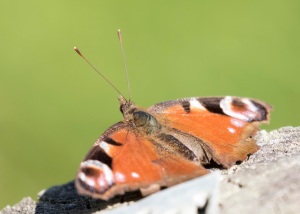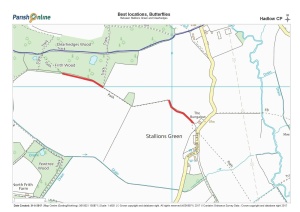The Peacock, Aglais io (until recently Inachis io)
The large and long-lived Peacock Butterfly can be found throughout the Parish for much of the year. The butterflies from the previous year are particularly easily seen on the footpaths across the farmland areas in the spring and early summer, February to June. These lay batches of eggs, and the resulting black spiky caterpillars feed in groups on nettle tips in summer, typically seen in May and June. The next generation of adults are then common visitors to gardens during the late summer and autumn, until about September or perhaps October, when they start to hibernate. It is, however, fundamentally a woodland species, preferably of open flowery rides and glades.
Description
The adult often appears a rusty mid-brown (or blackish, depending on the light) blur as it flies strongly past, but as it settles the large “eyes” on the top of the fore and hind wings become very obvious, and are thought to be used to frighten off predators, such as Blue Tits. The underside of the wings are very dark patterned grey by contrast, almost blackish, useful for camouflage while hibernating inside tree stumps and and other dark places.
This photo is of a fairly worn individual, perhaps a male, in late spring 2017, on top of a fence post on the edge of the arable field south of the Access Trail. This is a typical sunny sheltered path, with patches of bare baked earth, in which to find adult males loafing with intent in the spring or early summer.

and this is a close-up of the same individual’s head, showing its spotty eyes, and protruding palps:

This is a photo of a rather fresher individual in July 2014 taken in Dene Park, while it was taking nectar from a thistle head with its tongue, showing how dark the fresh underside of the hind-wing is – this general impression is retained throughout the adult butterfly’s life, although getting slightly more scuffed as time goes on. The detail of the patterning is subtle, and stunning when examined closely. The underside of the front wing is lighter and browner by comparison. When the underside of the wings is being displayed, the butterfly is said to resemble, in both shape and colour, a fallen leaf.
Note that as in the other Admirals, Browns and Fritillaries, only four of the six legs are fully developed, the front pair of these large butterflies are functionally un-important as legs. They may however be used as sensory detectors.

Distribution
Footpaths crossing the arable areas of the parish where it is often easier to find the overwintering Peacocks, Commas and Small Tortoiseshells in the spring and early summer are often paths oriented SE – NW with hedges or woodland on their leeward side, so that they catch the day’s sun, particularly in the afternoon, and are also protected from the prevailing wind from the SW. Corners are favoured as this is where females often fly past, and also they are recognisable landmarks. Here the male butterflies often rest on the short grass, or the bare earth of the path, baked in the sun, holding territory, sunning themselves or just resting in the afternoon warmth and waiting to challenge other butterflies as they pass. One example, between Stallions Green and where the footpath enters Clearhedges Wood is shown on the map below, but many other examples exist, to the North of the village along the River Bourne, and to the South of the village towards Golden Green, and the River Medway,

If other males pass by looking for their own territories, a dramatic contest begins, and they both spiral up into the air, competing for dominance. Sooner or later one flees, and the winner settles into the territory, usually the original occupant (89% in one small trial of 27 combats).
If you want to encourage Peacocks and the other larger butterflies into your garden in the autumn and early winter, try planting autumn flowering plants such as Buddleia, Marjoram, Salvias and Asters, and perhaps also leaving a few bruised apples cut in half on the ground in sunny patches, which may attract the butterflies to feast on the fermenting fruit. Peacocks are particularly and notably attracted to Buddleia flowers – perhaps 81% of all garden flower visits by this species are reported to be on Buddleia. By taking in these sugars and other carbohydrates, the butterflies can convert these and store fats in preparation for winter hibernation.
Although not a true migrant, nationally the butterfly tends to shift slightly north in the spring, slightly south in the autumn, by up to perhaps nearly 60 miles for the most adventurous individuals. It can be found throughout most lowland areas of the UK, having moved back into Scotland since the 1930s, re-colonising the Scottish south where it was known in the nineteenth century, and also moving further, into most other areas apart from the Highland region, It rarely crosses the sea, so UK populations are primarily resident in the UK with relatively little interchange with the continent, although there is probably some.
Life cycle
The adults overwinter as butterflies, waking up from their winter hibernation on warm days in spring, from January onwards, but becoming much commoner and easier to see from the middle of March onwards until June. Both genders spend the mornings nectaring, and then the males take up their territories in the afternoons, hoping for a female to pass by. If spotted, the females are chased by the males, and if the males keep up with the females (a test?), then mating is possible.
Once mated, the females tend to flee vigorously from the males, and search out nettle patches to lay large lumpy clusters of up to 400 eggs on leaf undersides of the nettle tips in May in sheltered warm and sunny positions, and the blackish caterpillars (more completely black than the Small Tortoiseshell caterpillars, which are a blackish green with thin yellow stripes just visible) live in obvious communal groups with some webbing through June, pupating in June or July.
The pupae are light grey on dark surfaces, yellow-green under leaves.
The next generation of butterflies appears from July or August onward, and those individuals will feed throughout the late summer and autumn, hibernate from September onward into the winter and then mate in their turn in the following spring. This means that each individual adult can live from July or August until possibly the next June, perhaps for well over ten months, hibernating quietly(?) for perhaps up to half of that time.
Here is a Youtube video of Peacocks nectaring off thistles and other flowers.
Oddities
This is one butterfly that seems to do better after a wet early summer, with large numbers of adults in that late summer, autumn and the following spring, possibly because of better growth of the caterpillars on nettles in these conditions. However in hot dry summers there may occasionally be a small second generation of caterpillars to try to catch up.
If disturbed when hibernating the butterflies are known to hiss audibly, by rubbing their wings together, sounding a bit like a snake! You might notice this if you come across one hibernating in your shed or woodpile!
In the least few years it has been moved from its original genus Inachis, which is now therefore redundant, into the large genus Aglais.
Parasites and predators
Parasitic wasps attack and kill very large numbers of the caterpillars.
Birds. mice and other predators can attack the hibernating adults, stripping their wings and eating the bodies.